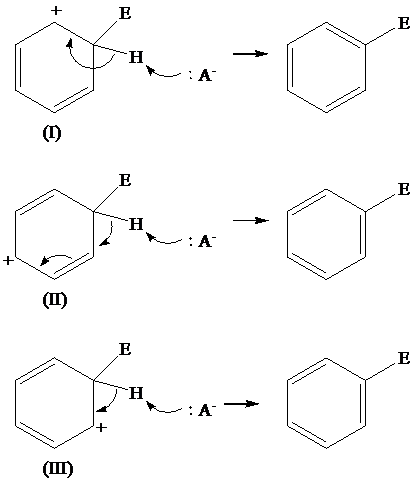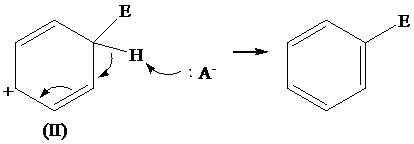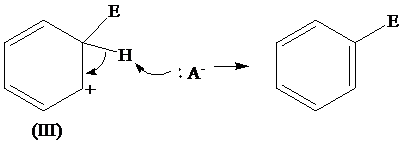
Concept explainers
PRACTICE PROBLEM 15.1
Show how loss of a proton can be represented using each of the three resonance structures for the arenium ion and show how each representation leads to the formation of a benzene ring with three alternating double bonds (i.e., six fully delocalized
Interpretation:
The loss of protons from three resonating structures of the areniumion, are to be shown.
Concept Introduction:
Arrows present in the mechanism of the reaction indicate the electron transfer, starting from negatively charged species and ending at the positively charged species.
Electrophiles attract negatively charged species and nucleophiles attract positively charged species.
Answer to Problem 1PP
Solution: The loss of protons from the three resonating structures of the arenium ion are shown as follows:

Explanation of Solution
The resonating structures of the arenium ion, formed in the electrophilic substitution reaction of benzene, are shown below:

The removal of proton occurs from the carbon atom where the electrophile is attached and the bond pairs of electrons of
The removal of proton from (I) resonating structure is shown as follows:

The removal of proton from (II) resonating structure is shown as follows:

The removal of proton from (III) resonating structure is shown as follows:

The removal of protons from the arenium ion leads to the transfer of bond pairs to the benzene ring and the delocalization of these electrons on the ring occurs, to form the final product.
Want to see more full solutions like this?
Chapter 15 Solutions
Organic Chemistry
Additional Science Textbook Solutions
Chemistry: The Central Science (14th Edition)
Chemistry & Chemical Reactivity
Organic Chemistry (9th Edition)
General, Organic, and Biological Chemistry: Structures of Life (5th Edition)
Chemistry
Organic Chemistry As a Second Language: Second Semester Topics
- Explain why pyridine N-oxide G can undergo nucleophilic aromatic substitution with nucleophile Nuc– to give product I. Include the resonance structures of pyridine N-oxide G to illustrate your answer.arrow_forwardStarting with benzene, toluene, or phenol as the only sources of aromatic rings, show how to synthesize the following. Assume in all syntheses that mixtures of ortho-para products can be separated into the desired isomer. Q.) m-Chlorobenzoic acidarrow_forwardWhen the nitrogen-containing aromatic heterocyclic compounds 1 and 2 are treated with HCl, only 1 forms the hydrochloride salt, whereas compound 2 is unreactive. Provide an explanation for this observed reactivity.arrow_forward
- A student was given from the list of the compounds below A, B and D blindly and asked to identify them all. He treated each of them with Brady's reagent (2,4-ditrophenylhydrazine) and isolated a bright yellow compound for one of them, but the other two gave false negatives. The student reasoned that the false negatives may be due to sterics and, on further thinking, it dawned on him that he might be able to rule out one of the false negatives with the haloform test. What compound did he find compatible with the haloform test? That compound did indeed give a false negative in the Brady test. Which of the other two was positive in the Brady test? A = haloform B = Brady A = haloform D = Brady B = haloform A = Brady B = haloform D = Brady D = haloform A = Brady D = haloform B = Bradyarrow_forwardGive the structure of compound 1 and compound 2arrow_forwardState the effect of substituents on a benzene derivative towards further aromatic substitutionarrow_forward
- Diazepam, better known as Valium, is a central nervous system (CNS) sedative/ hypnotic. As a sedative, it diminishes activity and excitement and thereby has a calming effect. Back in 1976, based on the number of new and refilled prescriptions processed, diazepam was the most prescribed drug in the United States. Following is a retrosynthetic analysis for a synthesis of diazepam. Note that the formation of compound B involves a Friedel-Crafts acylation. In this reaction, it is necessary to protect the 2° amine by prior treatment with acetic anhydride. The acetyl-protecting group is then removed by treatment with aqueous NaOH followed by careful acidification with HCl. Q. Is diazepam chiral? If so, how many of the possible stereoisomers are formed in this synthesis?arrow_forwardDiazepam, better known as Valium, is a central nervous system (CNS) sedative/ hypnotic. As a sedative, it diminishes activity and excitement and thereby has a calming effect. Back in 1976, based on the number of new and refilled prescriptions processed, diazepam was the most prescribed drug in the United States. Following is a retrosynthetic analysis for a synthesis of diazepam. Note that the formation of compound B involves a Friedel-Crafts acylation. In this reaction, it is necessary to protect the 2° amine by prior treatment with acetic anhydride. The acetyl-protecting group is then removed by treatment with aqueous NaOH followed by careful acidification with HCl. Q.Given this retrosynthetic analysis, propose a synthesis for diazepamarrow_forwardcompare reactivity of the compound below to that of benzene in electrophilic aromatic substitution.arrow_forward
- Bringing together your knowledge of the reaction chemistry of substituted benzenes, suggest a preparative route for conversion of compound A to compound B shown belowarrow_forwardProvide a mechanistic explanation for the following observation.arrow_forwardWhich is the stronger base: N-methylaniline (C6H5NHCH3) or benzylamine (C6H5CH2NH2). Explain your reasoning, supporting it with appropriate resonance contributors.arrow_forward
 Organic ChemistryChemistryISBN:9781305580350Author:William H. Brown, Brent L. Iverson, Eric Anslyn, Christopher S. FootePublisher:Cengage Learning
Organic ChemistryChemistryISBN:9781305580350Author:William H. Brown, Brent L. Iverson, Eric Anslyn, Christopher S. FootePublisher:Cengage Learning
